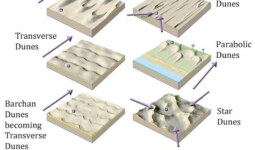Sulfur: A Comprehensive Guide for Geology Students
Introduction to Sulfur
Sulfur (S), one of the most abundant elements in the Earth’s crust, plays a crucial role in geology, both in mineral formation and environmental processes. It is a non-metal element found in a variety of forms, ranging from pure sulfur to compounds like sulfates and sulfides. Geology students should have a thorough understanding of sulfur’s properties, occurrence, and significance in geological formations.

1. Chemical and Physical Properties of Sulfur
Sulfur is known for its yellow color, brittle texture, and relatively low melting point. It exists primarily in two crystalline forms: orthorhombic and monoclinic. With an atomic number of 16, sulfur is classified as a non-metal and can form a variety of chemical compounds, particularly with oxygen (forming sulfates) and metals (forming sulfides).
- Atomic number: 16
- Atomic weight: 32.06 g/mol
- Melting point: 115.21°C
- Boiling point: 444.6°C
- Common forms: Sulfate (SO₄²⁻), Sulfide (S²⁻)
2. Sulfur’s Role in Mineral Formation
Sulfur is critical in the formation of sulfide and sulfate minerals, both of which are abundant in the Earth’s crust. Some of the most important sulfur-bearing minerals include:
- Pyrite (FeS₂): Commonly known as “fool’s gold,” it forms in sedimentary and metamorphic rocks.
- Galena (PbS): A primary source of lead, it often forms in hydrothermal veins.
- Gypsum (CaSO₄·2H₂O): A soft sulfate mineral formed in evaporite deposits.
These minerals provide essential resources like sulfur for industrial uses, as well as insight into geologic processes such as hydrothermal activity and sedimentary deposition.
3. Geological Occurrence of Sulfur
Sulfur is widely distributed in different types of geological settings. It is often found in:
- Volcanic Regions: Sulfur deposits are common in volcanic areas, where the element is released in gaseous form (SO₂) during eruptions. Solid sulfur often precipitates around fumaroles, creating deposits near volcanic vents.
- Sedimentary Environments: Sulfate minerals, like gypsum and anhydrite, typically form in evaporitic basins, where saline waters evaporate, leaving sulfur compounds behind.
- Hydrothermal Systems: Sulfides are common in hydrothermal veins, where hot, sulfur-rich fluids react with metals to form economically significant ore deposits, such as chalcopyrite (CuFeS₂) and sphalerite (ZnS).
4. Sulfur’s Role in Geochemical Cycles
Sulfur is a key element in Earth’s geochemical cycles. The sulfur cycle involves the movement of sulfur through the atmosphere, lithosphere, hydrosphere, and biosphere. Geology students should understand:
- Volcanic Emissions: Release of sulfur gases like sulfur dioxide (SO₂) into the atmosphere, contributing to acid rain and atmospheric processes.
- Oceanic Processes: Sulfur in seawater exists mainly as sulfate (SO₄²⁻), where it plays a role in biological and chemical processes, including the formation of certain sedimentary rocks.
- Biological Contributions: Bacteria in oxygen-deprived environments can reduce sulfate to sulfide, which then participates in the formation of minerals like pyrite.
5. Economic Importance of Sulfur
Sulfur is not only important for geological studies but also has vast industrial applications. It is primarily used in:
- Sulfuric Acid Production: Sulfur is a key raw material in the production of sulfuric acid (H₂SO₄), which is vital for manufacturing fertilizers, chemicals, and petroleum refining.
- Mining: Sulfide minerals are an important source of metals like copper, lead, and zinc. Understanding the sulfur content in ore bodies helps in the extraction and processing of these valuable metals.
- Energy Industry: Sulfur compounds in fossil fuels must be removed during the refining process to reduce air pollution and meet environmental standards.
6. Environmental Impacts of Sulfur
While sulfur is essential for many natural processes, it can also have harmful environmental effects. Geology students should be aware of:
- Acid Rain: When sulfur dioxide (SO₂) from volcanic eruptions or industrial processes reacts with water vapor in the atmosphere, it forms sulfuric acid, leading to acid rain that can damage ecosystems and geological formations.
- Mine Drainage: Sulfide minerals exposed to air and water can oxidize, producing sulfuric acid and leading to acid mine drainage, a major environmental issue in mining regions.
Conclusion: The Geological Significance of Sulfur
Sulfur is an essential element in the study of geology, influencing everything from mineral formation to environmental processes. By understanding sulfur’s chemical properties, geochemical roles, and occurrences in different geological settings, students can better appreciate its importance in both natural systems and industrial applications.
For geology students, a solid grasp of sulfur’s role in the Earth’s crust is essential for careers in resource extraction, environmental management, and academic research.
SEO Considerations:
- Target keywords: Sulfur, geological sulfur, sulfur in minerals, sulfur cycle, sulfide minerals, sulfate minerals, sulfur in geology.
- Meta description: Learn about the role of sulfur in geology, including its occurrence in minerals, geochemical cycles, and industrial importance. A guide for geology students.




Leave a comment